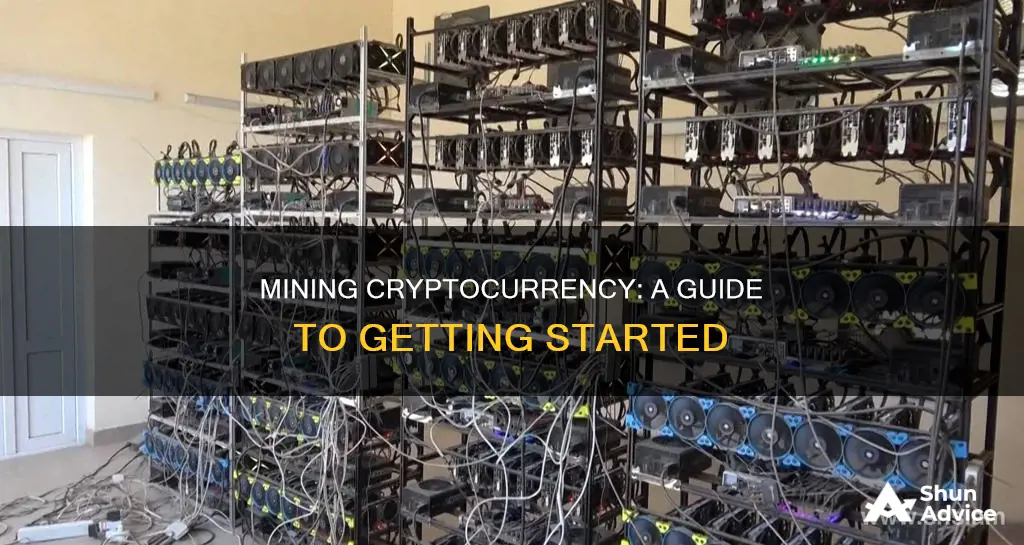
Crypto mining is the process of creating cryptocurrencies by auditing and processing crypto transactions. Miners verify data blocks on the blockchain, the digital public ledger that acts as the bedrock for Bitcoin and other cryptocurrencies. They also add the next “block,” or record of transactions, to the chain. To do so, a highly specialized computer solves a complex mathematical equation. Each attempt to solve the equation is called a hash, and the overall activity on the network is referred to as the hash rate. The first miner to solve the equation receives cryptocurrency as a reward.
There are several ways to invest in crypto mining. One way is to invest in cryptocurrency mining companies, which are responsible for creating new tokens. Another way is to invest in mining hardware and storage facilities, such as ASICs (Application-Specific Integrated Circuits), which can cost up to $10,000. Alternatively, investors can join mining pools, where groups of miners pool their collective hash rates to increase profits. Lastly, investors can participate indirectly through mining equity or standardized hash rate tokens.
What You'll Learn
- Understanding the process: mining adds blocks of data to a blockchain
- Hardware costs: machines can cost up to $10,000
- Energy prices: mining requires a lot of power
- Environmental impact: mining uses a lot of energy, which can be harmful
- Price of cryptocurrency: mining stocks tend to move with the price of crypto

Understanding the process: mining adds blocks of data to a blockchain
Mining is the process of adding a new block of transactions to the blockchain. It is a network-wide competition where any node on the network can work to try and add the next block to the chain. When a new block is mined, it is broadcast across the network, and each node independently verifies and adds it to their blockchain.
The mining process begins by filling a candidate block with transactions from your node's memory pool. This candidate block is what miners try to add to their blockchain and then send to everyone else so they can add it to their blockchain too. Every node keeps a copy of the latest transactions in their memory pool.
Next, a block header is constructed for this candidate block. This is a short summary of all the data inside the block, which includes a reference to an existing block in the blockchain that the new block wants to build on top of. This reference is made by using the previous block's block hash. A summary of all the transactions in the block is contained in the merkle root.
Now the block is ready to be mined. This involves putting the block header through the SHA-256 hash function twice. The target is the number that the block hash must get below to add the block to the blockchain. If the hash of your block header isn't below the target, you can keep trying by incrementing the nonce field in the block header. This allows you to keep the same basic block header but get a completely different hash result.
The mining process is a race to be the first node to get a low enough result. If you're lucky, you may end up getting a block hash that's below the current target. Once a miner manages to get a block hash for their candidate block below the target, they will broadcast that block to the rest of the network. Each node will then confirm that the block header hashes to below the target, then add this "mined" block to their blockchain.
After adding the new block, each mining node restarts the process to try to build on top of this new block in the chain. As a result, the blockchain is regularly updated thanks to a collaborative effort of nodes across the network.
Bitcoin in India: Is It Worth Investing?
You may want to see also

Hardware costs: machines can cost up to $10,000
The hardware costs of mining cryptocurrency can be extremely high, with machines costing up to $10,000 or more. The price of hardware is influenced by several factors, including the type of machine, its performance, and the current market demand.
The three main types of cryptocurrency mining hardware are ASICs (Application-Specific Integrated Circuits), GPUs (Graphics Processing Units), and CPUs (Central Processing Units).
ASICs are specifically designed for mining cryptocurrencies and offer the best performance in terms of hash rate and power consumption. However, they come at a high cost, often tens of thousands of dollars. For example, an ASIC machine capable of mining at 335TH with 16.0 joules per tera hash (16 watts at one trillion hashes per second) would cost more than $11,000.
GPUs are high-end graphics cards that can solve the complex mathematical equations required for mining. Popular options include the Nvidia GTX 1080 Ti or AMD RX Vega 64. GPUs can range in price from about $1,000 to $2,000.
CPUs are essential for performing the necessary calculations in the mining process, but they are less efficient than GPUs and ASICs. A CPU suitable for a mining rig, such as a quad-core Core i5, can be purchased for a few hundred dollars.
In addition to the base cost of the hardware, other factors can drive up the overall hardware expenses. For example, the current global semiconductor shortage has driven up prices for high-end chips. Additionally, the high demand for graphics cards from both miners and gamers has caused prices to soar.
When investing in cryptocurrency mining hardware, it is important to consider not only the upfront cost but also the ongoing power consumption and cooling costs. Mining hardware requires a significant amount of electricity to run, and the associated costs can eat into your earnings. Therefore, it is crucial to factor in power consumption and select hardware with high hash rates and low power consumption to improve mining productivity and reduce energy bills.
Furthermore, a reliable cooling system, such as fans or water coolers, is necessary to maintain optimal hardware performance and prevent overheating. These additional components can also add to the overall hardware costs.
Ghanaian Guide to Bitcoin: Getting Started with Crypto
You may want to see also

Energy prices: mining requires a lot of power
Energy prices are a key factor in determining a crypto miner's profitability. Mining cryptocurrency requires a lot of electricity to run the powerful computers that solve complex calculations. The energy usage for miners depends on several factors, including the availability of cheap and plentiful power, energy-efficient hardware, and the difficulty of the problems being solved to earn cryptocurrency rewards.
Miners are incentivized to find the cheapest energy sources available, and with the decreasing price of renewable energy, many are turning to these sources to power their operations. According to the Cambridge Centre for Alternative Finance, an estimated 76% of Bitcoin miners use some form of renewable energy, and almost 40% of their energy comes from renewables.
The low cost of renewable energy is one reason why there is so much crypto mining in China. During China's rainy season, hydroelectric dams produce excess energy, and energy prices drop. Miners take advantage of these low prices by connecting their warehouses of servers to hydroelectric power sources. When the rainy season ends, they switch back to coal or other cheaper energy sources.
The energy consumption of cryptocurrency mining operations has drawn the attention of policymakers and grid planners concerned about its effects on cost, reliability, and emissions. In the United States, for example, cryptocurrency mining is estimated to represent between 0.6% and 2.3% of the country's electricity consumption. This additional electricity use has prompted concerns about strains on the electricity grid during peak demand, potential increases in electricity prices, and the impact on carbon dioxide emissions.
The massive amount of energy consumed by crypto mining has also been criticized for its negative environmental impact. As a result, some mining companies are moving towards carbon-neutral practices and seeking cleaner and greener energy sources, such as geothermal or solar power.
A Beginner's Guide to Investing in Ripple Coin
You may want to see also

Environmental impact: mining uses a lot of energy, which can be harmful
Cryptocurrency mining is an extremely energy-intensive process. The process of mining Bitcoin, for example, involves solving complex mathematical problems or "proofs of work" that require a lot of computational power. The energy consumed by Bitcoin mining alone is estimated to be as much as the energy used by small countries. This energy consumption has a significant environmental impact, contributing to the climate crisis and global warming.
The energy used for cryptocurrency mining often comes from burning fossil fuels, which emit large amounts of carbon dioxide and other greenhouse gases. For instance, the amount of carbon dioxide produced by Bitcoin mining each year is estimated to be comparable to the emissions of Greece in 2019. Other estimates place the annual carbon footprint of Bitcoin mining at around 55 million tons, similar to the carbon emissions of Singapore.
The high energy consumption of cryptocurrency mining also has indirect environmental impacts. The increased demand for energy can strain energy grids and raise retail electricity rates. Additionally, the short time horizon of mining operations means that most miners have little incentive to invest in new clean energy sources. Instead, they often seek out readily available energy sources, including coal and gas plants, which contribute to air and water pollution.
The environmental impact of cryptocurrency mining has led to concerns and criticism from environmental groups and activists. Some groups, such as Greenpeace, are urging financial institutions involved in Bitcoin mining to reduce their environmental impact by changing the code that produces Bitcoin to consume less electricity. They argue that a less energy-intensive verification process, such as the "proof of stake" method used by Ethereum, could significantly reduce the carbon footprint of cryptocurrency mining.
While some in the Bitcoin community disagree with the idea of changing the code, others suggest that the use of renewable energy sources for mining could be a potential solution. By partnering with renewable energy companies, mining companies can take advantage of periods of excess energy production and share the wealth generated. However, the reality is that very few mining facilities are building new renewable energy sources to power their operations.
Smart Guide: Investing 5K in Cryptocurrency
You may want to see also

Price of cryptocurrency: mining stocks tend to move with the price of crypto
The price of cryptocurrency is one of the three key factors that determine a crypto miner's profitability, alongside hardware costs and energy prices. When crypto prices rise, mining companies' stock prices may also rise, similarly to how gold mining companies' stocks can become more valuable when gold prices rise.
The market value of crypto assets rose to nearly $3 trillion in November 2021, up from $620 billion in 2017, as a result of soaring popularity among retail and institutional investors. This has led to a greater interconnectedness between virtual assets and financial markets.
Before the pandemic, crypto assets such as Bitcoin and Ether showed little correlation with major stock indices. However, this changed after the extraordinary central bank crisis responses of early 2020. Crypto prices and US stocks both surged amid easy global financial conditions and greater investor risk appetite.
For example, the correlation coefficient between the daily moves of Bitcoin and the S&P 500, the benchmark stock index for the US, jumped from 0.01 in 2017-2019 to 0.36 in 2020-2021. This suggests that Bitcoin has been acting as a risky asset, with a higher correlation to stocks than other assets such as gold or investment-grade bonds.
The increased co-movement between crypto and equity markets indicates a growing interconnectedness between the two asset classes, which can transmit shocks that can destabilize financial markets. As a result, there are calls for a comprehensive, coordinated global regulatory framework to guide national regulation and supervision and mitigate the financial stability risks stemming from the crypto ecosystem.
Bitcoin: Currency or Investment?
You may want to see also
Frequently asked questions
Cryptocurrency mining is the process of creating cryptocurrencies by auditing and processing cryptocurrency transactions. Miners verify data blocks on the blockchain, a digital public ledger that acts as the bedrock for Bitcoin and other cryptocurrencies.
Miners solve complex mathematical equations to add another block of data to a blockchain. Each attempt to solve the equation is called a "hash", and the overall activity on the network is referred to as a "hash rate". The miner who solves the equation is rewarded with the cryptocurrency they are mining.
The risks of mining are generally financial. Mining requires a lot of effort and expensive equipment with no guarantee of a return on investment. It may also be illegal in some jurisdictions. Cryptocurrency mining is also criticised for its negative environmental impact and large carbon footprint.
In the same way that investing in a gold mine offers unique advantages to buying gold directly, investments in cryptocurrency mining offer advantages over buying cryptocurrency directly. The most obvious benefit is the constant stream of cryptocurrency being generated, regardless of price.
There are several ways to invest in cryptocurrency mining, including hardware mining, mining pools, mining equity, and standardised hashrate tokens.







